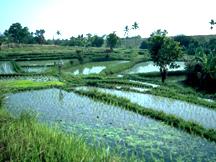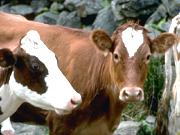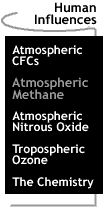
Go to
the "Carbon Dioxide" puzzle piece
for more information about Human Influences on this gas.
Global
Climate Change: Human Influences-- Atmospheric Methane
Freshwater wetlands
are a common source of the atmospheric
greenhouse gas methane
(CH4). The methane produced in wetlands is the result of the metabolic
process of certain mico-organisms called "methanogens." This
process occurs in nearly all freshwater wetlands--including those that
are constructed by humans.
 One very important constructed
freshwater wetland is the rice paddy. A rice paddy is a plot of land that
is flooded in order to grow rice. As the human population grows, so does
the area
of land covered by rice paddies to produce the important
food crop. This leads to an increase in the amount of CH4 released to
the atmosphere. Photo © 2000-www.arttoday.com One very important constructed
freshwater wetland is the rice paddy. A rice paddy is a plot of land that
is flooded in order to grow rice. As the human population grows, so does
the area
of land covered by rice paddies to produce the important
food crop. This leads to an increase in the amount of CH4 released to
the atmosphere. Photo © 2000-www.arttoday.com |
 Methane is also produced in
the stomachs of cattle, another major food source. Cattle and other
grazing animals release large amounts of methane in their intestinal gas
(flatulence). In fact, the flatulence of animals is a significant source
of methane. However, research has shown that larger herds of cattle and
other grazing animals is not related to increased concentrations of this
greenhouse gas in the atmosphere. Photo © 2000-www.arttoday.com Methane is also produced in
the stomachs of cattle, another major food source. Cattle and other
grazing animals release large amounts of methane in their intestinal gas
(flatulence). In fact, the flatulence of animals is a significant source
of methane. However, research has shown that larger herds of cattle and
other grazing animals is not related to increased concentrations of this
greenhouse gas in the atmosphere. Photo © 2000-www.arttoday.com |
Overview
..|..
Human
Influences
..|..
Impacts
Atmospheric
CFCs / Atmospheric Methane / Atmospheric
Nitrous Oxide / Tropospheric Ozone
/ The Chemistry
Glossary ..|..
Related
Links ..|..
References
|..
PBL
Model
Home ..|.. Teacher Pages ..|.. Modules & Activities
HTML code by Chris
Kreger
Maintained by ETE
Team
Last updated November 10, 2004
Some images © 2004 www.clipart.com
Privacy Statement and Copyright © 1997-2004 by Wheeling Jesuit University/NASA-supported Classroom of the Future. All rights reserved.
Center for Educational Technologies, Circuit Board/Apple graphic logo, and COTF Classroom of the Future logo are registered trademarks of Wheeling Jesuit University.

